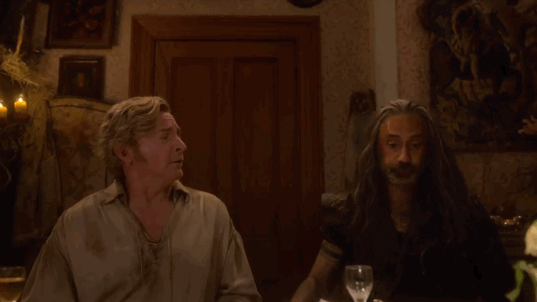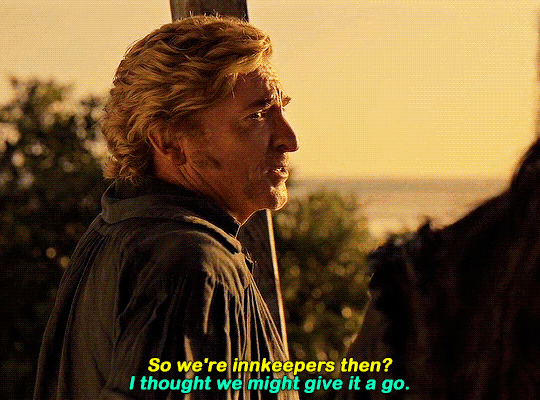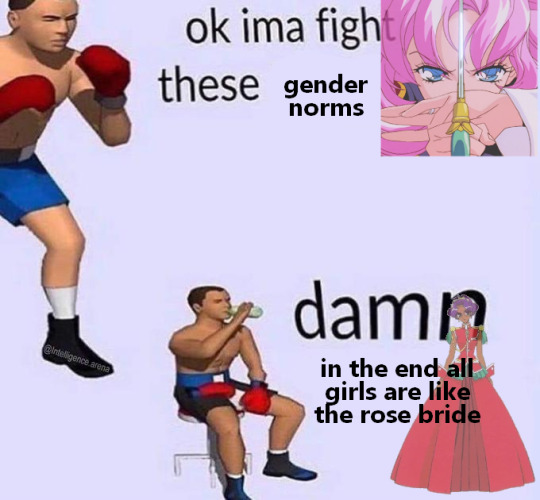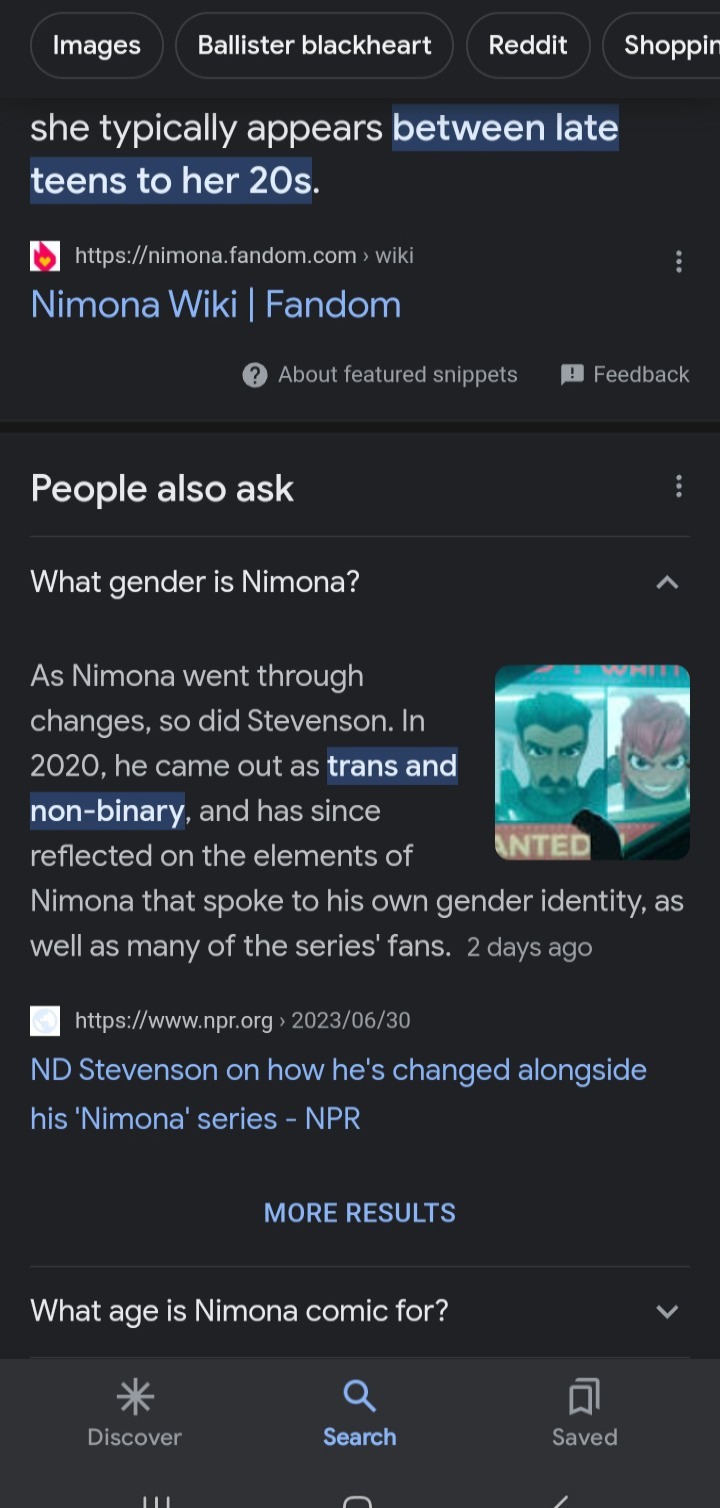#gendered norms
Text
The Tolkienesque Renaissance and the woman-wizard
A long time ago I made a brief post about my personal vision of a certain "Tolkienesque Renaissance" era within English-speaking literature, following/coexisting with the "Tolkien Subversion" era that was formed by Earthsea, Elric, The Black Company and other classics.
It was meant to be the first post in a whole series but I kind of got busy with other things... That being said I do want to make this post about one of the fascinating traits of the Tolkienesque Renaissance. A trait which seems to be overlooked or misunderstood today due to the very polarizing matter and the quick shifts occuring in our societies about this topic, but needs to be highlighted: the gender roles. Well more specifically the gender roles within the magic part of the fantasy world.
In 1985, Terry Pratchett created a talk/article which was forgotten for a given time, until it popped up on the Internet in the 2000s/2010s, and was more recently reprinted in book format (in posthumous anthologies of his talks, articles and essais) and even translated in other languages (the only French translation of this text dates from a few years ago). This text is called "Why Gandalf never married", and it is a very important mini-essay when it comes to the English-speaking fantasy literature because it highlighted very well (and in Pratchett's usual humoristic way) the gender "norms" within the Tolkien-model of fantasy ; but more importantly how this gendered system was carried on, consciously or unconsciously, by other authors in the fantasy genre.
I strongly suggest you go check out the original article, it is disponible for free on several websites, and I won't recap it here. But it made a point that many other analysists and historians of the fantasy genre relayed. The Tolkien model of the magic-use has magic lying within the hands of a men, and escaping the hands of women. In The Lord of the Rings the magic is the domain of the Wizards - which is an order of exclusively male entities. That's the Gandalf of the title. There is no female Wizard in the Tolkienesque world, and the closest thing we get to a female magic user within The Lord of the Rings is Galadriel - but Galadriel is in this specific plotline a secondary character with not as much importance or active power as the likes of Gandalf and Saruman, and she even denies herself that what she does is magic, carefully explaining that Elves merely consider what others call their "magic" advanced craft, technology and skills. Galadriel has the appearance of an enchantress, but in truth is not, and all the true magic relies within the male-only Gandalf.
And this model was carried on into a lot of the fantasy series and novels that followed the publication of The Lord of the Rings, even those that were created specifically to subvert the "Tolkienesque fantasy". In his article, Pratchett ranked alongside Gandalf as the celibate wizard-heroes of male dominance, Ged from Earthsea... by Ursula K. Le Guin, which is an author as far from woman-hating as the Sun is far from Pluto. And yet... Pratchett did point out that in the Earthsea series it is made extremely clear that only men can be true wizards, the "wizarding school" of this setting only teaches men, and when a woman has magical power, she is a secondary and weak witch with only a handful of simple abilities, unable to match any great "true" wizard. Even worse: when a woman actually shows some great talent and manages to challenge or outbeat the wizard... it is because she derives her power from malevolent sources and evil entities. It is true in Earthsea.
Or at least it was true. Indeed, we have to put things back in context: when Pratchett made this analysis, Earthsea was just a trilogy. Not just "a" trilogy, but rather a halted series: Le Guin had written the first three Earthsea books, and she wanted to return to writing more Earthsea but in her own words something felt wrong, she didn't find how to go on, she sense there was a problem with Earthsea though she could not identify what exactly... This is part of why the fourth book of the series was released 18 YEARS after the third. And the exact reason Le Guin was weirded out by her own series is precisely what Pratchett pointed out - and something Le Guin herself had to re-discover within her own work (Now I cannot claim that Pratchett's article actually helped Le Guin see this "gendered flaw" within her own novels, because I have no reliable source about Le Guin reading Pratchett's text or being aware of this talk - but given I heard it had quite an influence upon its release I do think it played a part in it). This is also why Le Guin returned to Earthsea by the late 80s: she had identified the problem in her own work, women were trapped in a gendered system denying them access to "true magic". And from "Tehanu" onward, she worked to - not correct - but improve this worldbuilding fact, for example by pointing out the inherent misogyny of her own world, by explaining the reasons that led to women being excluded of the art of magic, and by revealing that women and men are in fact equal in magic by nature but not by society.
[Note: I do wish to say that it is not an inherently bad or evil thing to have a "gendered" magic system within your fantasy work. The entire point of the fantasy is that you can do everything and anything and explore any possibility. You can have a magic system where only one gender can have magic ; you can have a magic system where spells are bound to a specific age ; you can have magic system where only rocks can perform magic because flesh cannot stand it - in itself, it is not a bad thing... The problem here that Pratchett denounced was how a specific gendered-model of magic bearing misogynistic traits within it was spreading around and becoming an untold law of the fantasy genre, to the point even feminist writers applied it without realizing it.]
Pratchett completed his trio of "male-dominated and somehow misogynistic" magic systems by adding to Gandalf and Ged the figure of Merlin from the Arthurian romances and epics, as one of the main cultural influences of magic within fantasy... but also one of the roots of the unconscious misogyny that was growing within fantasy. Because in the Arthurian world, not only is Merlin the most prominent wizard and enchanter, he is seen as the "source" and "true bearer" of magic, with the two famous Arthurian sorceresses, Viviane and Morgan, being explicitely his students - women learned magic from a man. And not only did they learned it from him, they both used it in a bad and negative way. Morgan to become a wicked witch and the enemy of the heroes ; Viviane to betray her own mentor and trap the wizard forever (with in many versions this being seen as a selfish action, some authors even pushing it as far as making Viviane one of the instruments of the Arthurian downfall). Of course there are very interesting talks, debates and analysis to have about this strange triangle of magic-users - especially since one of Merlin's gifts was prophecy and foresight, and it is implied that he knew what he was doing when he taught these women magic, somehow accepting that his lessons would be used against him and his work... But that's a talk for another day and it doesn't change how it influenced mid-20th century fantasy in a bad way.
As such, from Merlin to Ged passing by Gandalf, Pratchett made this conclusion: in English-speaking fantasy as it existed in the mid 80s, "true" wizards were men, and magic belonged to the male gender. And when a women practiced magic (if they could even practice magic), they were either depicted as weaker and inferior to men, either as evil antagonists corrupting magic or using it for nefarious purposes. Hence "Why Gandalf never married".
This talk is also very important to understand the very origins and building of Pratchett's own brilliant parody-deconstruction-reconstruction of the fantasy genre, his "Discworld" series. In his Discworld books Pratchett prepared several entire plotlines to explain, dissert and explore the gendered cliches and normative stereotypes of magic in fantasy, with the archetype of the male-magic through the Wizards and of the female-magic through the Witches. "Why Gandalf never married" was created in 1985... two years before Discworld's third book "Equal Rites", which is a brilliant parody of these same gender norms as a girl becomes fated to become a Wizard and fights for it, in a cloistered world where women can only hope to be Witches and nothing else.
Now, all of that being said, I return to my point about the Tolkienesque Renaissance. And I will claim that this "movement" actually inherited Pratchett's point or was conscious of it because, interestingly, all these revivals of the classical Tolkien-like fantasy worked very hard to break the gender norms of magic, and have prominent female magic users not depicted as evil. Mind you, they never went as far as Le Guin or Pratchett did in their own work, and in fact several of these works came to be criticized by later generations for being themselves too-gendered, too-cliche, or even misogynistic... However I do believe that it is important to highlight how these works, which might not fit our own modern gender equality or our modern view of women, still were a first step forward, a certain breakthrough, in a fantasy landscape where women were either denied magic or locked withn the "wicked witch" stereotype.
The Fionavar Tapestry series has one of the main female characters becoming The Seer, a benevolent and respected magic user. She is not of the same "type" as the wizards of the setting and lacks a magic as powerful as them, but is still an heroic supernatural character on which the story focuses. There is also an exploration of the gendered norm by having a Council of Mages from which women are lacking (and coming with historical explanations about the role of women in relationship to them) clashing with an all-female order of priestesses of a Great Goddess (a conflict which itself also is echoed by a gendered pantheon of Great Gods and Great Goddesses working in mysterious ways towards each other).
The Belgariad makes a clear effort by "doubling" the typical wizard-mentor into a duo, Belgarath the Sorcerer and Polgara the Sorceress, with Polgara being a powerful magic user equal in strength to Belgarath and working alongside him, but staying a benevolent and heroic character (though there is a dark side to her, from her stern and harsh personality, to a worldbuilding prophetic element about her possibly turning evil).
The Wheel of Time seems to avoid the topic entirely by completely reversing the norm: all magic-users are female, the male magic-users were all wiped out, and if they exist they have to be deprived of power else they will become evil. Now we still have a more nuanced approached in terms of moral since the Aes Sedai mix in one go the all-benevolent Gandalf-like figure with the manipulative and dreaded wicked witch - but the gender treatment and balance within "The Wheel of Time" has been debated and discussed a LOT so I won't go further into this.
Memory, Sorrow and Thorn literaly has a female Gandalf in the character of Geloë - who also has a few elements of Baba-Yaga in her most positive incarnations. There's still a bunch of evil witches throughout the series outgrowing in number the rare positive female magic users, but Geloë stands out as the big powerful helpful witch of the "hero's party".
As I said, these characters are of course not perfect. There are things to be said against them in a more modern light, or they might be judged as not good characters at all... But it doesn't change the fact that Geloë, Polgara and Moiraine are quite important in the history of fantasy as breakers of a system that was imposed by Merlin, Gandalf and Ged - and while they cannot answer the question of "Why Gandalf never married", they are proofs that "Gandalf can be a woman".
#fantasy#tolkienesque renaissance#magic#magic system#magic in fantasy#terry pratchett#witches#discworld#ursula k. le guin#earthsea#wizards#memory sorrow and thorn#geloëk#gendered norms#ged#gandalf#polgara#belgariad#misogyny#misogyny in fantasy#the wheel of time#moiraine#the fionavar tapestry#history of fantasy
42 notes
·
View notes
Text

5K notes
·
View notes
Text












Rule #2: The locksmith will not be required to participate in battle
(read this post and this post for more context lol)
#dungeon meshi#aj art#chilchuck#beabell#tw ed implied#Also disclaimer that probably isn’t needed but jic#He isn’t having a toxic masculinity moment#It’s the opposite#He resents the gender norms in his culture and is basically making sure he stays in the “wife” role#Because he wants his wife and daughters to be as unburdened by said norms as possible#I dont usually add disclaimers on my shit bc I like ppl to have their own interpretations#But that’s sort of important to me for my portrayal of him as a character#Chilchuck backstory stuff
2K notes
·
View notes
Text
"we need weirder queer identities" y'all can't even handle queer mascs
#transandrophobia#man hating is stupid#you really gonna go out there and hate 50% of the world's population?#for their fucking gender identity?#don't you see that's exactly what we're supposed to be fighting against?#are men really lesser because they were born men#or are you just mad about gender norms and toxic masculinity and taking ut out on individuals rather than the system#bored.txt
1K notes
·
View notes
Note
I ABSOLUTELY ADORE YOUR SQQ HE LOOKS SO FUCKINH DONE WITH LIFE

The recipe for SQQ is: calm on the outside, screaming on the inside.
#poorly drawn svsss#svsss#shen qingqiu#ask#No joke I'm pretty sure he is my favourite 'guy gets transporte'd to another world' character#I recently rewatched the (sadly never to be continued) animated version of SVSSS and I cant get over how perfect he is for the role#He is *so* done with everything going on around him. Forced to be calm and mean. Born to scream and be kind.#The gap between the internal and external dialogue is one of my fav character/writing quirks.#The personification of the 'he lied' dialogue tag.#Love how deep the SVSSS meta and literary analysis community gets with him. Piosplayhouse has opened my eyes to trans SQQ#what is the system is *not* a metaphor for pressure to adhere to societal norms of gender and sexuality?#I really need to finish the books...that is probably my biggest burning hole in my 'DNF' pile. I liked it! I just got busy.
1K notes
·
View notes
Text
this is by no means comprehensive, as this app has a skewed demographic to begin with, but I'm just trying to decide on whether this is a worthwhile topic for the women and gender studies project I'm doing.
#im sorry i know this is so not dyslexia friendly but i didn't know how else to word it#science side of tumblr#queer#queer community#double minority#adhd#audhd#autism#lgbt#lgbtq#lgbtqia#lgbtq community#neurodivergent#actually neurodiverse#neurodiversity#gender studies#fuck gender norms#queer pride#trans#transgender#poll#tumblr polls
2K notes
·
View notes
Text


#dominated slave#female led relationship#sissy domination#sissy bitch#sissy loser#chastity tease#gender norms#sissy for daddy#female led husband#married submisive
537 notes
·
View notes
Text

‘You left me for Mary?’
On the one hand, it’s obvious why Ed is upset by this. It is framed as a betrayal, an infidelity, directly in conflict with what Stede and Ed shared previously, however briefly.
But I think there’s a little more to this.
Ed’s angry. Because to Ed, Stede left him for a lie. Stede’s sexuality is complex, but however it can be defined, it does not involve a cis woman. Ed knows this. He knows this. You only have to observe the incredulity on Ed’s face when Anne Bonny says Stede kissed her. He is flummoxed and bewildered and so, so hurt by learning Stede returned to Mary.
The hurt runs much deeper than Stede’s single act. Stede has colluded with society’s norms after appearing to reject them, social mores which actively hurt someone such as Ed - I trusted you.
Ed knows he lives in a comphet society, even if on the fringes, within a pirate subculture with differing norms and values. It’s the reason why Ed attacks the wedding party. It’s the reason why he keeps the cake-toppers and attempts to imprint a version of himself over the top of the bride. Ed tries desperately to erase the smooth-faced, upper-class white woman, the perfect companion to the smooth-faced, upper-class white man. The thing he can never be. It’s what society upholds as correct sexual, emotional and moral behaviour. We hear the words of the vicar at the wedding on the ship clear as day: ‘The natural condition of humanity is base and vile. It’s the obligation of people of standing, such as yourselves [white, hetro, upper class] to elevate the common human rabble through the sacred transaction of matrimony’.

Ed cannot belong to a man like Stede. Ed is too male, too brown, too low-born. He is part of the ‘rabble’. After painting himself upon the bride, he pushes both figures out of the broken window into the sea. To kill the thing that can never be, the ‘base and vile’ want within him. A want that is condemned. And by pushing the bride figurine into the sea, he foreshadows the death of the man who would ever think such a love and life could be his. Himself. It is a truly desperate moment of self-loathing.
But Stede does come back. His actions did not occur in isolation. He is as much a victim of a comphet society as Ed, despite some of the privileges being white and upper-class bring. He rejects finally the comphet grand narrative lie of his upbringing and returns to the truth of his heart and being.
Stede finally tells the too male, too brown, too low-born Ed that actually, he is endgame for him. Not within a society which will crush them, but in a world they can build and create for themselves.
This can be whatever we want it to be.
Eventually, eventually, Ed heals enough to listen and believe a little, and see enough of a future in which he can simply be loved by Stede and love Stede in return.

Which is one of the many, many reasons this show will break and remake my heart forever.
#ed teach#stede bonnet#gentlebeard#mary bonnet#comphet#race#class#gender#norms and values#pirate subculture#endgame#truth#our flag means death#ofmd#ofmd meta
277 notes
·
View notes
Text
A central element of the myth of [Eleanor of Aquitaine] is that of her exceptionalism. Historians and Eleanor biographers have tended to take literally Richard of Devizes’s conventional panegyric of her as ‘an incomparable woman’ [and] a woman out of her time. […] Amazement at Eleanor’s power and independence is born from a presentism that assumes generally that the Middle Ages were a backward age, and specifically that medieval women were all downtrodden and marginalized. Eleanor’s career can, from such a perspective, only be explained by assuming that she was an exception who rose by sheer force of personality above the restrictions placed upon twelfth-century women.
-Michael R. Evans, Inventing Eleanor: The Medieval and Post-Medieval Image of Eleanor of Aquitaine
"...The idea of Eleanor’s exceptionalism rests on an assumption that women of her age were powerless. On the contrary, in Western Europe before the twelfth century there were ‘no really effective barriers to the capacity of women to exercise power; they appear as military leaders, judges, castellans, controllers of property’. […] In an important article published in 1992, Jane Martindale sought to locate Eleanor in context, stripping away much of the conjecture that had grown up around her, and returning to primary sources, including her charters. Martindale also demonstrated how Eleanor was not out of the ordinary for a twelfth-century queen either in the extent of her power or in the criticisms levelled against her.
If we look at Eleanor’s predecessors as Anglo-Norman queens of England, we find many examples of women wielding political power. Matilda of Flanders (wife of William the Conqueror) acted as regent in Normandy during his frequent absences in England following the Conquest, and [the first wife of Henry I, Matilda of Scotland, played some role in governing England during her husband's absences], while during the civil war of Stephen’s reign Matilda of Boulogne led the fight for a time on behalf of her royal husband, who had been captured by the forces of the empress. And if we wish to seek a rebel woman, we need look no further than Juliana, illegitimate daughter of Henry I, who attempted to assassinate him with a crossbow, or Adèle of Champagne, the third wife of Louis VII, who ‘[a]t the moment when Henry II held Eleanor of Aquitaine in jail for her revolt … led a revolt with her brothers against her son, Philip II'.
Eleanor is, therefore, less the exception than the rule – albeit an extreme example of that rule. This can be illustrated by comparing her with a twelfth century woman who has attracted less literary and historical attention. Adela of Blois died in 1137, the year of Eleanor’s marriage to Louis VII. […] The chronicle and charter evidence reveals Adela to have ‘legitimately exercised the powers of comital lordship’ in the domains of Blois-Champagne, both in consort with her husband and alone during his absence on crusade and after his death. […] There was, however, nothing atypical about the nature of Adela’s power. In the words of her biographer Kimberley LoPrete, ‘while the extent of Adela’s powers and the political impact of her actions were exceptional for a woman of her day (and indeed for most men), the sources of her powers and the activities she engaged in were not fundamentally different from those of other women of lordly rank’. These words could equally apply to Eleanor; the extent of her power, as heiress to the richest lordship in France, wife of two kings and mother of two or three more, was remarkable, but the nature of her power was not exceptional. Other noble or royal women governed, arranged marriages and alliances, and were patrons of the church. Eleanor represents one end of a continuum, not an isolated outlier."
#It had to be said!#eleanor of aquitaine#historicwomendaily#angevins#my post#12th century#gender tag#adela of blois#I think Eleanor's prominent role as dowager queen during her sons' reigns may have contributed to her image of exceptionalism#Especially since she ended up overshadowing both her sons' wives (Berengaria of Navarre and Isabella of Angouleme)#But once again if we examine Eleanor in the context of her predecessors and contemporaries there was nothing exceptional about her role#Anglo-Saxon consorts before the Norman Conquest (Eadgifu; Aelfthryth; Emma of Normandy) were very prominent during their sons' reigns#Post-Norman queens were initially never kings' mothers because of the circumstances (Matilda of Flanders; Edith-Matilda; and#Matilda of Boulogne all predeceased their husbands; Adeliza of Louvain never had any royal children)#But Eleanor's mother-in-law Empress Matilda was very powerful and acted as regent of Normandy during Henry I's reign#Which was a particularly important precedent because Matilda's son - like Eleanor's sons after him - was an *adult* when he became King.#and in France Louis VII's mother Adelaide of Maurienne was certainly very powerful and prominent during Eleanor's own queenship#Eleanor's daughter Joan's mother-in-law Margaret of Navarre had also been a very powerful regent of Sicily#(etc etc)#So yeah - in itself I don't think Eleanor's central role during her own sons' reigns is particularly surprising or 'exceptional'#Its impact may have been but her role in itself was more or less the norm
357 notes
·
View notes
Text

I have no excuse.
#traditional art#luigi#my au#bowuigi#will I ever stop drawing Luigi in dresses?#no#not until gender norms are thrown in a trash compactor
291 notes
·
View notes
Text

#rgu#sku#revolutionary girl utena#shoujo kakumei utena#utena#a talking c00kie#so tempted to draw this.#i k now its Not Just gender norms and whatever. but im not putting a paragraph in there#1k#2k
2K notes
·
View notes
Text
i like to think goth is a gender in of itself
#goth#gothgoth#gothic#gender#gothgender#i usually just go by nonbinary but gothgender resonates quite a bit tbh#and there is something to be said about the overlap between the trans community and the goth community#and especially with how goth often rejects typical gender norms#idk there's definitely an essay to be written here but im not good at articulating my thoughts#but i dont really get dysphoria from looking more feminine or masculine the way i do if i feel like i look too preppy#and being able to be goth feels like its improved my mental health#idk tho im just someone on the internet throwing words at a wall
871 notes
·
View notes
Text


I am actually frothing at the mouth. This is glorious.
#nimona#lgbtqiia+#lgbtq#lgbtqplus#genderfluid#nonbinary#non bianry#down with the gender norms#im feral#going feral#nd stevenson#transgender
1K notes
·
View notes
Note
get out of heeere i thought that redhead alien in plaid was a handsome butch alien lesbian
LMAO!!! Pollination Technician #9 could be a butch alien lesbian if he wanted to.
PT9 and his femme wife, Jenny!
185 notes
·
View notes
Text
Adrien modelling masc clothing for his father his whole childhood, eventually disappearing from the modelling world in his adulthood against his fathers wishes, then coming back out of the blue modelling fem/masc/androgynous clothing under his girlfriends fashion company :33333 (a huge rival to agreste fashion hehe)
#miraculous ladybug#mlb#marinette dupain cheng#breaking gender norms#Let adrien be fem#genderfluid adrien agenda#why isn’t genderfluid!adrien more popular#ml ladybug#adrien agreste
369 notes
·
View notes
Text

TRADITIONAL TOAD GARB PEACH LETS GOOOOOOOO
#smb#princess peach#no id#giddly’s art#inhales. Okay. listen#while i understand why they did it i have beef with the fact that the peach toad garb scene in the smb movie saw her in a tee shirt#listen to me. the toads do not have gender norms. i’m pretty sure they don’t have gender at all [?]#i have NO reason to believe that peach would be the ONLY one in the kingdom wearing a shirt. like why. WHY#however i do think that by the time she got old enough to travel outside the mushroom kingdom and was exposed to other cultures#her wardrobe would get more variety simply because she would become interested in other kinds of garments. like ok#but the toads have a completely different society altogether. they all dress Exactly the same#they’re like. smurfs. actually the parallels between the smurfs / smurfette & princess peach / her toads are so numerous it’s not even funn#ANYWAY what i’m trying to say is that they would raise her like one of their own. they wouldn’t treat her any differently#she [HOLD THAT THOT I JUST REMEMBERED THAT TOADETTE EXISTS AND LOOKED HER UP. SHE WEARS A FUCKING SHIRT.#OKAY WHATTTTEVER. i refuse to believe the toad society of all fucking things cares about gender norms#whatever. it’s my hc and i can do whatever i want forever#source: my beautiful mind
179 notes
·
View notes